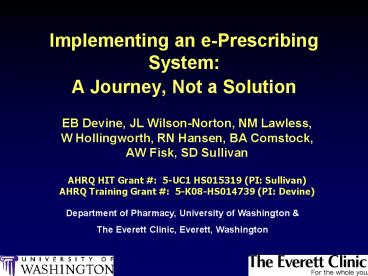Implementing an ePrescribing System: A Journey, Not a Solution PowerPoint PPT Presentation
1 / 20
Title: Implementing an ePrescribing System: A Journey, Not a Solution
1
Implementing an e-Prescribing System A Journey,
Not a Solution
- EB Devine, JL Wilson-Norton, NM Lawless,
- W Hollingworth, RN Hansen, BA Comstock,
- AW Fisk, SD Sullivan
- AHRQ HIT Grant 5-UC1 HS015319 (PI Sullivan)
- AHRQ Training Grant 5-K08-HS014739 (PI
Devine)
Department of Pharmacy, University of Washington
The Everett Clinic, Everett, Washington
2
The Everett Clinic
- Physician owned and managed multi-specialty
integrated health-system with a 83-year history - 14 locations 60 clinics
- Ancillary services
- 260 physicians/ 1,500 employees
- 225,000 patients
- 700,000 ambulatory visits annually
- 2.5 million Rx annually
3
The Everett Clinics e-prescribing system
- CliniTech? Information Resources
- Internally-developed EHR began in 1995 charts,
labs and imaging reports - e-prescribing implemented beginning during
2003-05 - Features of e-prescribing system
- Web-based
- Write new refill prescriptions
- Output fax/ print
- Optimizes choice of medication generates
medication list as prescriptions are written - Pediatric antibiotic dosing by weight
- Utilizes subscription to commercial drug database
as back end - Builds patient drug database, improving disease
management
4
Implementation of e-prescribing
- Several months in development
- Accuracy and relevance of drug database
- Screens easy to use and involve minimal
manipulation - Basic decision support
- Adopt an icon MedMan
- Implement at pilot site refills first
- Voluntary use
- Goal Implement on platform of wireless laptop
- Switch to hardwired desktops in exam rooms
- 505 exam rooms!
- 51 months to last clinic go-live
- Now 5,000 prescriptions/ day (95 written)
faxed to 600 pharmacies - Transition to vendor-purchased EHR in late 2007
CDS customized use becomes mandatory
5
AHRQ HIT GrantSpecific Aims
- Capture lessons learned during implementation
- Evaluate impact on medication errors and adverse
drug events - Measure impact on workload / workflow
- Time-motion study
- Process metrics (chart pulls, prescriptions
written) - Evaluate impact on human factors
- Focus groups
- Survey assessing readiness to adopt IT
6
Implementation Lessons (1)
- Culture
- Visionary leadership safety-oriented positive,
upbeat work environment - Two-way communication constant
- Iterative implementation
- Re-engineering / standardization of workflow
integral to process - Adequate investment in infrastructure a priori
speed is essential for adoption - End-user prior experience variable and influences
user attitudes - Adequate testing and feedback
- Just-in-time, one-on-one training 24 / 7 help
7
Implementation Lessons (2)
- Use early adopters as trainers
- Users interested in research results as
motivation for adoption - Medication safety, workflow / workload
- Focus groups provided opportunity to provide
feedback - Retail pharmacies are stakeholders, too
- Patients love looking at their data with their
physician - Many exam rooms not large enough for computer
- Need retrofitting
- Maintenance includes ongoing monitoring and
development of plans for system downtime - Customization of purchased system
- With great care detailed work
8
Medication error study
- Aim
- Evaluate the impact of e-prescribing on
medication errors and adverse drug events (ADEs) - Capture error characteristics and severity
- Methods
- Pre-/ post- study
- Retrospective review, 10,000 scripts (3,000 for
pilot study at 1 internal medicine clinic) - Adopted definition and severity index of the NCC
MERP1 - Data sources prescriptions, EHR, laboratory
values, hospital admit / discharge / emergency
department notes
1National Coordinating Council for Medication
Error Reporting and Prevention.
http//www.nccmerp.org/aboutMedErrors.html
9
Incidence of Potential and Medication Errors
10
Severity of Potential and Medication Errors
11
Characteristics of Errors
12
Time-motion study
- Aim
- Evaluate whether the implementation of
e-prescribing was at least time-neutral for
physicians and staff members - Methods
- Shadowed each user over a 4 hour shift
- 8am -12 noon, or 1pm-5pm
- With consent of clinician patient
- Data collected with Timer ProTM
(http//performance-measurement.com) - Categories adapted from Overhage
Overhage. JAMIA 20018361-71
13
Time-motion study design
- Controlled Pre- Post Study
14
Time-motion results Overall task types
(prescribers)
pclinics all other tasks took 15
Time-motion results Prescribing-related events
(prescribers)
Linear mixed effect model, adjusted for
prescriber and type of prescription (new/renew)
16
Focus group study
- Aim
- Explore and describe prescriber staff
experiences with and perceptions of the
e-prescribing system - Methods
- Qualitative research
- Universal sample in 3 clinics / 3 stages of
implementation - 30 minutes/ group 3-8 participants oral consent
- Semi-structured elicitation techniques
- 4 domains expectations, impact, fears, barriers
to adoption - Analysis with Atlas.ti? software
17
Focus group results
- 8 focus group 67 participants (17 prescribers
52 RNs MAs) - Computer background influenced perceptions
18
Research Conclusions
- The Everett Clinic / University of Washington a
valuable partnership - Medication errors
- e-prescribing reduces medication errors
- eliminates types of errors (illegibility,
abbreviations) - introduces new types of errors (picking errors)
- standardizes care / reduce unnecessary variation
- data available to optimize quality lower cost
of prescribing - Time-motion workload / workflow
- e-prescribing has minimal impact on prescriber
time (12 seconds per event) - Workload
- 95 of prescriptions written electronically
- Number of monthly chart pulls decreased from
- 5,800 (2003) to 650 (2007) 9-fold reduction
- Focus groups
- impact beneficial users do not wish to go back
to paper-based prescribing
19
Questions?bdevine_at_u.washington.edu
20
Characteristics of Errors

